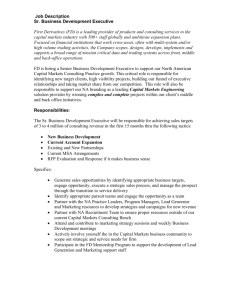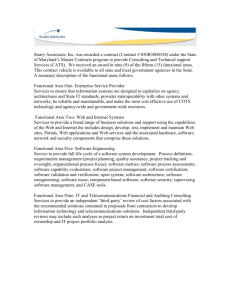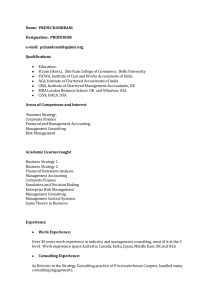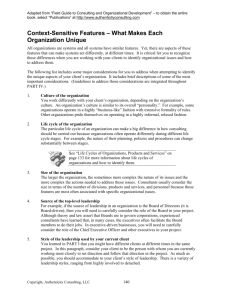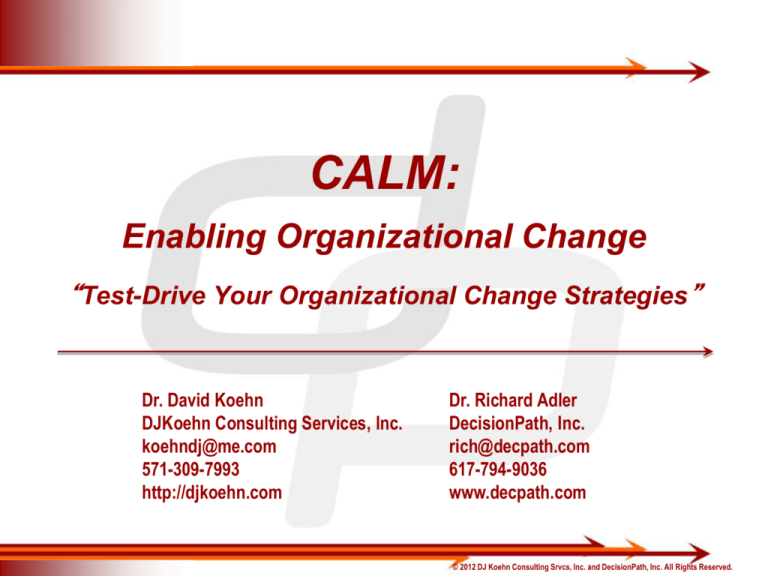
CALM:
Enabling Organizational Change
“Test-Drive Your Organizational Change Strategies”
Dr. David Koehn
DJKoehn Consulting Services, Inc.
koehndj@me.com
571-309-7993
http://djkoehn.com
Dr. Richard Adler
DecisionPath, Inc.
rich@decpath.com
617-794-9036
www.decpath.com
© 2012 DJ Koehn Consulting Srvcs, Inc. and DecisionPath, Inc. All Rights Reserved.
Agenda
• Organizational Change
– What is it?
– Why is it so hard?
– A better way to enable effective change in your organization
•
•
Change Adaptation Learning Model (CALM)
Key features
- Pragmatic
- Measurement-based
- Dynamic: provides flexibility to respond to continual change
- Fast (but intense)
© 2012 DJ Koehn Consulting Srvcs, Inc. and DecisionPath, Inc. All Rights Reserved.
2
Organizational Change
• Organizations compelled to change by their environments
– New laws, increased workloads, new technologies...
• Common responses
– Modify structures, processes, IT systems, offerings…
• But….
– Change alters status quo & moves people out of their comfort zone
– Creates fear, uncertainty, resistance
© 2012 DJ Koehn Consulting Srvcs, Inc. and DecisionPath, Inc. All Rights Reserved.
3
Change “Management” (CM)
• Anticipate disruptions that impair focus & performance
• Try to avoid or mitigate loss of momentum & productivity
– Prepare and guide organization and employees
• Great idea, except…
– 70+% of change management initiatives fail
– Costing tens of billions of dollars annually in US alone*
•
Consulting fees, write-offs, severance costs, IT purchases,…
*Sources: Surfing the Edge of Chaos, R. Pascale, M Millemann, L Gioja;
Creating Contagious Commitment, A Shapiro.
© 2012 DJ Koehn Consulting Srvcs, Inc. and DecisionPath, Inc. All Rights Reserved.
4
Why Traditional CM Fails?
• Typical CM approaches are largely tactical
– Communicating
– Training – new systems or processes
– Activities amenable to project management methods
• Necessary, but not sufficient
• Social and personal behaviors aren’t mechanical like IT
• Traditional CM does not impact culture, norms, beliefs, and habits
• These factors can’t be scheduled or controlled
• Do not generate the trust, confidence, and energy required to
•
achieve and sustain change
Change is continual, not a single event
© 2012 DJ Koehn Consulting Srvcs, Inc. and DecisionPath, Inc. All Rights Reserved.
5
What is CALM?
• Methodology and supporting software to enable change
– Change Adaptation Learning Model
• Treats change as a strategic (core) competency
• Pragmatic & measurement-based
– Readiness to change, in three “dimensions”
•
Socio-cultural / workforce psychology / business “infrastructure “
– Measure current levels and envision goal/target state
• Dynamic planning
– Identify change activities & business case for doing them
•
Schedule, cost, estimated impact on readiness metrics
– Anticipate impacts of situational forces, trends, events
– Simulate plan to test and validate or refine prior to roll-out
© 2012 DJ Koehn Consulting Srvcs, Inc. and DecisionPath, Inc. All Rights Reserved.
6
Measuring Readiness to Change
• CALM defines three “dimensions” of readiness metrics
• Assessed on a scale of 1 to 100 by org. change team
• Consensus estimates, documenting points of view, justifications
• Net value for dimension is computed from values of component metrics
Org. Mindset
Personal Mindset
Cultural Coherence
Org. Alignment
Leadership Change Capacity
Teaming
BPR & CPI,
Technology Upgradeability,
Operational Agility,
Organizational Adaptiveness
Mental Schema Dev.,
Work Preferences,
Learning Capability,
Competency Dev.
Functional
Personal & Social
Infrastructure
© 2012 DJ Koehn Consulting Srvcs, Inc. and DecisionPath, Inc. All Rights Reserved.
7
CALM Models Change Dynamics
Organizational Unit
External
Forces
Change Dimensions
Org. Mindset
Personal Mindset
Great
Outstanding
Good
Events
Change Path
Baseline
Infrastructure
Internal
Forces
Transformation Plan
Change Initiatives
© 2012 DJ Koehn Consulting Srvcs, Inc. and DecisionPath, Inc. All Rights Reserved.
8
Demo Case Study
• Government organization
– Department of Defense
– 10000+ employees, union shop
• Change challenge
– Replacing traditional seniority-based compensation
system with pay for performance scheme
• Initial focus
– Tactical programs to train employees to complete annual
objectives and managers to conduct annual reviews
– Failed to address critical socio-cultural and psychological
issues driving acceptance by workforce
© 2012 DJ Koehn Consulting Srvcs, Inc. and DecisionPath, Inc. All Rights Reserved.
9
Demo
© 2012 DJ Koehn Consulting Srvcs, Inc. and DecisionPath, Inc. All Rights Reserved.
CALM – When to Use It
• Before change
– Ideally, use CALM as a planning tool up-front
• During execution
– Routine monitoring
•
Periodically update Scenarios & re-project change strategy
- Early Warning of emerging problems, allowing prompt
diagnosis and mid-course adjustment
– Crisis
•
•
Capture strategy, environment, goals explicitly
Diagnose problems, devise & validate new/modified plan
• Post-change
– Continuous learning
© 2012 DJ Koehn Consulting Srvcs, Inc. and DecisionPath, Inc. All Rights Reserved.
11
CALM Benefits
• Comprehensive
• Strategic
• Dynamic “lifecycle” support
• Unique model/”what-if” simulation drives systems thinking
– “Practice” change strategies & learn from low-cost virtual mistakes
– Monitor execution, detect problems, make mid-course fixes
• Fast and cost effective
– Develop and validate change strategies in weeks, not months
– Small consulting team leads facilitated workshops, analysis
• Reduce risk, improve confidence & consistency
© 2012 DJ Koehn Consulting Srvcs, Inc. and DecisionPath, Inc. All Rights Reserved.
12


